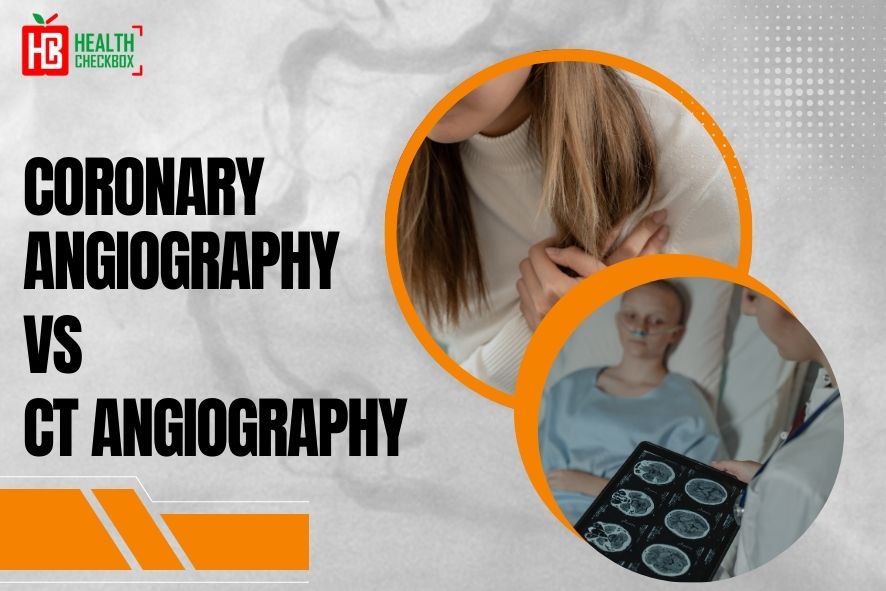Maintaining good heart health is very important and helpful for ourselves later in life. But there are several types of heart conditions with which people are dealing. To diagnose heart conditions, a medical team always takes the help of imaging to diagnose the issue. From which the two major diagnostic processes that cardiologists use are Coronary Angiography and CT Angiography. So, this blog will help you to find the best in Coronary Angiography vs CT Angiography, considering their risks, benefits, recovery time, and lifestyle changes.
Knowing the basic difference between them and their functionality helps the patients ensure the best angiography for them. Especially for the patient dealing with various heart issues like cardiac complications, congestive heart failure, and coronary artery disease.
What is Coronary Angiography?
Coronary artery angiography is considered the best possible treatment for coronary artery disease to date. This angiography is specifically valuable for patients experiencing pain in chest pain, showing signs of heart failure, or cardiac arrest. The process for this treatment is minimally invasive and involves the following steps:
- A small incision is made.
- A catheter tube is inserted via the artery in the wrist.
- It is threaded to the coronary arteries of the heart.
- A contrast dye is injected in the same area to make it visible to identify the blockages.
- It could be a blockage, narrowed arteries, or any other complications.
This detailed image helps doctors prepare a suitable coronary artery disease treatment plan. And also decides whether there is a need for surgery or not.
Understanding CT Angiography
It is non non-invasive technique that is done by using tomography. CT Angiography, also known as coronary CT Angiography or Cardiac CT. The process of its functionality is detailed below:
- A contrast dye is injected into the veins
- A CT Scanner takes multiple X-rays from various angles
- Combining all the X-rays to create a 3D view of the heart
The objective is to identify the blockage or any narrowing in the vessels or the heart. So that doctors can plan an appropriate treatment or surgery if required. It is a very popular method because, if we compare it with traditional coronary angiography, it is much less invasive. And it may be the best choice for patients who are not eligible for catheter insertion.
Key Differences Between Coronary Angiography vs CT Angiography
| Factors | Coronary Angiography | CT Angiography |
| Accuracy and Detail | It shows the live blood flow and real-time images, which makes it easier to detect. | It’s not live, the pre-clicked images and stable images are harder to detect any small blood clog. |
| Invasiveness | It is minimally invasive and uses the insertion of a catheter tube, which makes most patients ineligible for this. | It is non-invasive, and most of the patients are eligible for this. |
| Recovery Time | It takes a few hours to recover from the incision site, or the patient may experience a mild fever due to this. | No certain physical effect, a patient can do their normal activities immediately after the angiography |
| Risk Profile | It has more risk due to its nature of surgery. Bleeding, damage to vessels may cause infection | It has a slight risk due to the contrast dye. As some people tested good for the angiography, but later their bodies might react with the contrast dye. |
Recommendation of Coronary Angiography and CT Angiography
The preference for both angiography depends on various things, as below:
Coronary Angiography is Preferred When:
- Proper evaluation is required before a surgery.
- The patient is showing symptoms of coronary artery disease.
- Experienced unstable angina or survived cardiac arrest.
- High chance of the requirement of angioplasty.
- Past medical tests suggest significant blockages.
CT Angiography is Ideal For the Patients:
- Patients who are not eligible for an invasive procedure.
- Required in follow-up after coronary artery disease treatment.
- Experiencing extreme chest pain and high blood pressure.
- Screening for patients with low risk or moderate risk of coronary artery disease.
- Before any surgical procedure, it is essential to know the exact anatomy of the vessels and the heart.
Role in Heart Failure Management
Both Angiography play a major role in different aspects, as we have already discussed above. Understanding the difference between angiography and angioplasty is also crucial here. Angiography is a diagnostic procedure, and Angioplasty is a treatment that is performed immediately if any blockage or disease is found in angiography. For patients with congestive heart failure, imaging is very important to identify the disease and blockages.
Early detection of congestive heart failure symptoms is beneficial for timely treatment. Heart failure symptoms are also common to see these days because of a poor lifestyle and unhealthy weight maintenance. There are some early symptoms of heart failure you must know about:
- Fatigue and nausea
- Breathing shortness
- Swelling in the ankles and legs
- Unwanted rapid weight gain
- Upper back pain
These indicators should never be ignored, as early detection and early treatment can change the total outcome.
Lifestyle Considerations for Heart Health
Regardless of any angiography or any treatment. Maintaining good heart health is very necessary, and it depends on your lifestyle. Changing your lifestyle a little in a positive direction can help you a lot. The best diet for the heart includes so many things, like:
- Green vegetables
- Whole grains
- Lean proteins and fish
- Avoid packaged and processed food
- Limit sodium intake
Regular workout and exercise help in managing stress, which is directly linked to cardiac heart failure. Avoid the consumption of tobacco and alcohol.
Beyond Coronary Applications
Apart from coronary-related treatments, angiography is a process that extends to other areas also. For eg, renal angiography treatment is very popular for diseases and issues related to the kidney blood vessels. This shows the need for imaging is very diverse in the medical world, and multiple surgeries.
Decision between Coronary Angiography and CT Angiography
The decision between the angiographies depends on various things, as given below:
- It depends on the overall health status.
- Age factor
- Allergies to dye contrast
- Past medical condition
- Urgency of diagnosis
For the patient showing the critical symptoms of heart failure disease, doctors will recommend the proper diagnosis for it as on the symptoms. Sometimes, CT angiography skips to detect the minor blockages. On the other hand, coronary angiography is best if there is a requirement for a detailed image for evaluation.
Conclusion
Coronary Angiography vs CT Angiography, Both are popular and advanced tools in the modern medical world. Each one of them has its own advantages over the others. Knowing the difference and their functionality will help the patient choose better treatments.
Whether you are evaluated for heart failure, congestive symptoms, artery disease, or other heart conditions, these imaging tools provide a data of detailed images. It helps in planning the appropriate and effective treatment for the patients. However, if you don’t have any related disease, it is still important to maintain heart health.

